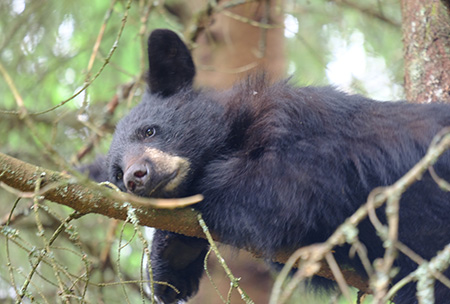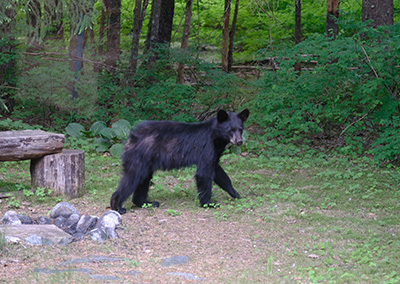Alaska Fish & Wildlife News
July 2018
Yearling Black Bears in Alaska
Transition to Independence

It’s normal for mother black bears to “kick their cubs loose” in June – typically cubs that are about a year-and-a-half old. For Alaskans living in prime black bear habitat that can mean we witness our young black bear neighbors making their transition to independence. Sometimes it’s a bit painful to watch.
“The phone has been ringing off the hook with people worried about cubs,” said state wildlife biologist Carl Koch, who is based in Douglas in Southeast Alaska. He said callers were heartbroken, concerned that the yearlings were starving orphans. He guessed he’d received 15 calls the week of the summer solstice. “It’s like the switch was flipped,” he said, with mother bears in the area emancipating their young.
ADF&G staff in Juneau and Douglas noted in 2017 that there were a significant number of cubs of the year; the recent uptick in reports of young bears isn’t necessarily surprising and affirms the high quality black bear habitat around Juneau.
It’s mating season, and the mother bears are becoming interested in adult male bears. A mother black bear with cubs of the year, born this winter during hibernation, is not interested in mating this year. But a mother black bear with yearling cubs is generally ready to turn her attention away from her cubs. Grizzly bears, known in coastal areas as brown bears, tend to keep their cubs for two or even three years, but once that mother is ready to mate again the process is similar. Sometimes the mother bear will actively drive her cub or cubs away, and sometimes the intimidating presence of an adult male bear contributes to the breaking of the family bond.
“The cubs have this shock, mom chased them away and she’s no longer around to back them up,” Koch said. “Now they have to figure out what to eat and what to do when they run into other bears, even mom, who might just run them off again. It can sometimes take a while to get the message.” During this period it isn’t uncommon to see sibling yearlings together. Remaining together likely provides some comfort for siblings that have been separated from their mother and it can mean people may encounter more than one yearling bear at a time.

Last year these mother bears taught their cubs what to eat, how and where to forage, and the general life skills they need to survive on their own. The young bears are doing the best they can.
“During this period, if they learn that trash or chickens is an easy meal, we’re going to have problems down the road,” Koch said. “We put up a loaner electric fence on Monday where a yearling bear was going after chickens. Everyone with chickens should have an electric fence.”
Electric fences can easily be ordered online, and the Fish and Game website provides suggestions (see the end of the article). Area hardware, gardening and building supply stores often have them in stock.
A few Fish and Game area offices have fences available for short term loan.
The office in Douglas has about five electric fences to temporarily loan to folks in the Juneau area and the Wildlife Conservation desk can be contacted at 465-4265. The Nome office also has a loaner, the number is 443-8191. Nome biologist Bill Dunker said it is handy for folks who want to learn how they work and test the technology before buying one, and good for short term use like a fish drying project.
The Kodiak office has loaner fences, (486-1880), and the Kodiak National Wildlife Refuge (487-2600) also loans them to campers and hunters in the area. There are also some rental fences available in some areas through businesses such as Kodiak Kamps and Alaska Bear Fence Rental.

Koch said that people are sometimes intimidated by electric fences, but they are actually pretty straightforward once you learn how to set one up. “We have videos online that show how to do it, and we can help people if they tell us they have a fence and it’s not working. We have a tester we can bring over or loan so people can be sure the fence is working.”
It’s understandable that people are concerned about the young bears wandering around or hanging out up in trees. “Yearlings have these long legs, big ears, and often they’re shedding this time of year so they look like they’re in poor health, but they’re not,” Koch said. “Black bears are good climbers and being in trees is normal. It’s how they escape from danger, so it’s very common for them to climb a tree when they feel threatened. That’s also why they can easily climb over fences. People say, ‘My garbage is in the back yard so it’s okay.’ It might keep a coyote out, but a chain link fence is not going to stop a black bear.”
Calls about bears to local police or Fish and Game offices are often related to garbage - unsecured garbage is the number one attractant that keeps bears coming around, Koch said. Keeping the trash can in the garage until right before pickup is a good solution, as is using bear-resistant containers. Freezing food scraps, especially fish scraps, minimizes the smell, then put them in the can right before pick up.
Bird feeders are also a significant attractant. “We’ve had several calls about yearlings in bird feeders – I responded to a yearling in a bird feeder last night,” Koch said. “Birds do not need to be fed in the summer. There is plenty of natural food out there. Bird seed is a very high-calorie food; bears have excellent noses and they’re going to go after it. And unfortunately, then they’re going to stick around. This is a critical time in their lives to not learn bad habits.”

Koch said that many of the yearlings in the Juneau area have been seen eating wild foods like green vegetation. They’ll eat dandelions, grasses and sedges, dig the roots of groundcone and chocolate lily, and they eat insects. It won’t be long before berries are available, and then salmon.
As with any bears, please give these yearlings plenty of room, and secure attractants. With a little time and the arrival of berries and fish, these bears will learn how to live and survive on their own and to avoid people.
A Framework for Bear Safety Messages in Alaska
Riley Woodford is an information officer with the Division of Wildlife Conservation. He produces the online magazine Alaska Fish and Wildlife News and the Alaska nature radio program, Sounds Wild!
The mention of specific businesses or products serves as examples and is not an endorsement.
Subscribe to be notified about new issues
Receive a monthly notice about new issues and articles.
